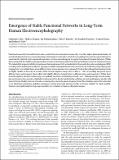| dc.contributor.author | Chu, Catherine Jean | |
| dc.contributor.author | Kramer, Mark R. | |
| dc.contributor.author | Pathmanathan, Jay Sriram | |
| dc.contributor.author | Bianchi, Matt Travis | |
| dc.contributor.author | Westover, Michael Brandon | |
| dc.contributor.author | Wizon, L. | |
| dc.contributor.author | Cash, Sydney S. | |
| dc.date.accessioned | 2016-12-09T21:13:16Z | |
| dc.date.issued | 2012 | |
| dc.identifier.citation | Chu, C. J., M. A. Kramer, J. Pathmanathan, M. T. Bianchi, M. B. Westover, L. Wizon, and S. S. Cash. 2012. “Emergence of Stable Functional Networks in Long-Term Human Electroencephalography.” Journal of Neuroscience 32 (8) (February 22): 2703–2713. doi:10.1523/jneurosci.5669-11.2012. | en_US |
| dc.identifier.issn | 0270-6474 | en_US |
| dc.identifier.uri | http://nrs.harvard.edu/urn-3:HUL.InstRepos:29663464 | |
| dc.description.abstract | Functional connectivity networks have become a central focus in neuroscience because they reveal key higher-dimensional features of normal and abnormal nervous system physiology. Functional networks reflect activity-based coupling between brain regions that may be constrained by relatively static anatomical connections, yet these networks appear to support tremendously dynamic behaviors. Within this growing field, the stability and temporal characteristics of functional connectivity brain networks have not been well characterized. We evaluated the temporal stability of spontaneous functional connectivity networks derived from multi-day scalp encephalogram (EEG) recordings in five healthy human subjects. Topological stability and graph characteristics of networks derived from averaged data epochs ranging from 1 s to multiple hours across different states of consciousness were compared. We show that, although functional networks are highly variable on the order of seconds, stable network templates emerge after as little as ∼100 s of recording and persist across different states and frequency bands (albeit with slightly different characteristics in different states and frequencies). Within these network templates, the most common edges are markedly consistent, constituting a network “core.” Although average network topologies persist across time, measures of global network connectivity, density and clustering coefficient, are state and frequency specific, with sparsest but most highly clustered networks seen during sleep and in the gamma frequency band. These findings support the notion that a core functional organization underlies spontaneous cortical processing and may provide a reference template on which unstable, transient, and rapidly adaptive long-range assemblies are overlaid in a frequency-dependent manner. | en_US |
| dc.language.iso | en_US | en_US |
| dc.publisher | Society for Neuroscience | en_US |
| dc.relation.isversionof | doi:10.1523/JNEUROSCI.5669-11.2012 | en_US |
| dash.license | LAA | |
| dc.title | Emergence of Stable Functional Networks in Long-Term Human Electroencephalography | en_US |
| dc.type | Journal Article | en_US |
| dc.description.version | Version of Record | en_US |
| dc.relation.journal | Journal of Neuroscience | en_US |
| dash.depositing.author | Chu, Catherine Jean | |
| dc.date.available | 2016-12-09T21:13:16Z | |
| dc.identifier.doi | 10.1523/JNEUROSCI.5669-11.2012 | * |
| dash.contributor.affiliated | Kramer, Mark | |
| dash.contributor.affiliated | Pathmanathan, Jay Sriram | |
| dash.contributor.affiliated | Chu, Catherine | |
| dash.contributor.affiliated | Bianchi, Matt Travis | |
| dash.contributor.affiliated | Westover, Michael | |
| dash.contributor.affiliated | Cash, Sydney | |


